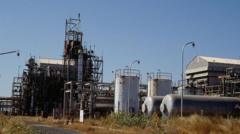The removal of toxic waste from the Bhopal gas leak site marks a significant milestone in addressing decades of environmental and health hazards in the region.
Toxic Waste from Bhopal Gas Leak Finally Removed After Four Decades

Toxic Waste from Bhopal Gas Leak Finally Removed After Four Decades
India successfully transports hazardous waste from the infamous Union Carbide factory
Authorities in India have successfully transported approximately 337 tonnes of hazardous waste from the Union Carbide plant in Bhopal, 40 years after one of the deadliest industrial disasters in history. This monumental step came after a December ruling by the Madhya Pradesh High Court, demanding the safe disposal of the waste within a stipulated four-week timeframe.
The toxic materials, consisting of pesticide residues and "forever chemicals," have been contaminating groundwater in the vicinity, posing ongoing health risks to residents. The gas leak, which occurred in December 1984, resulted in an immediate death toll of around 3,500 people, with more than 15,000 fatalities attributed to long-term health complications related to the exposure. Activists argue that the death toll could be significantly higher.
Transportation of the hazardous waste began under tight security measures, involving police escorts and emergency response teams. The waste is currently en route to an incinerator facility located approximately 230 kilometers away, where it is expected to undergo treatment over the next three to nine months.
The incineration process has faced opposition from local residents and environmental activists, who fear previous attempts at disposing of the toxic waste have resulted in additional pollution. In 2015, a trial incineration at a different facility reportedly led to soil and water contamination, further alarming community members. However, officials, including Swatantra Kumar Singh from the Bhopal gas tragedy relief and rehabilitation department, have assured the public that precautions have been taken to prevent any adverse environmental impacts.
The journey to this point has been fraught with challenges, including governmental inaction and backlash from local activists over numerous proposed disposal sites. Despite efforts made since 1984, including a 2010 court conviction of former plant managers with minor penalties, many victims feel that justice and resolution remain elusive.
The saga of the Bhopal gas tragedy underscores a complex narrative, intertwined with themes of accountability, environmental justice, and the lasting impacts of industrial negligence. As the toxic waste finally begins to leave the site, the attention turns toward future safeguards to protect the health of those living in proximity to the hazardous legacy left behind.
The toxic materials, consisting of pesticide residues and "forever chemicals," have been contaminating groundwater in the vicinity, posing ongoing health risks to residents. The gas leak, which occurred in December 1984, resulted in an immediate death toll of around 3,500 people, with more than 15,000 fatalities attributed to long-term health complications related to the exposure. Activists argue that the death toll could be significantly higher.
Transportation of the hazardous waste began under tight security measures, involving police escorts and emergency response teams. The waste is currently en route to an incinerator facility located approximately 230 kilometers away, where it is expected to undergo treatment over the next three to nine months.
The incineration process has faced opposition from local residents and environmental activists, who fear previous attempts at disposing of the toxic waste have resulted in additional pollution. In 2015, a trial incineration at a different facility reportedly led to soil and water contamination, further alarming community members. However, officials, including Swatantra Kumar Singh from the Bhopal gas tragedy relief and rehabilitation department, have assured the public that precautions have been taken to prevent any adverse environmental impacts.
The journey to this point has been fraught with challenges, including governmental inaction and backlash from local activists over numerous proposed disposal sites. Despite efforts made since 1984, including a 2010 court conviction of former plant managers with minor penalties, many victims feel that justice and resolution remain elusive.
The saga of the Bhopal gas tragedy underscores a complex narrative, intertwined with themes of accountability, environmental justice, and the lasting impacts of industrial negligence. As the toxic waste finally begins to leave the site, the attention turns toward future safeguards to protect the health of those living in proximity to the hazardous legacy left behind.






















